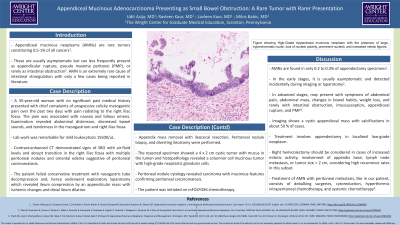Sunday Poster Session
Category: Small Intestine
P1293 - Appendiceal Mucinous Adenocarcinoma Presenting as Small Bowel Obstruction: A Rare Tumor With Rarer Presentation
Sunday, October 22, 2023
3:30 PM - 7:00 PM PT
Location: Exhibit Hall

Has Audio

Udit Asija, MD
The Wright Center for GME
DUNMORE, PA
Presenting Author(s)
Ravleen Kaur, MD1, Udit Asija, MD2, Lavleen Kaur, MD1, Milos Babic, MD1
1The Wright Center for Graduate Medical Education, Scranton, PA; 2The Wright Center for GME, Scranton, PA
Introduction: Appendiceal mucinous neoplasms (AMNs) are rare tumours constituting 0.5-1% of all cancers. These are usually asymptomatic but can less frequently present as appendicular rupture, pseudo myxoma peritonei (PMP), or rarely as intestinal obstruction. AMN is an extremely rare cause of intestinal strangulation with only a few cases being reported in literature.
Case Description/Methods: A 35-year-old woman with no significant past medical history presented with chief complaints of progressive colicky mesogastric pain over the past two days with pain radiating to the right iliac fossa. The pain was associated with nausea and bilious emesis. Examination revealed abdominal distension, decreased bowel sounds, and tenderness in mesogastrium and right iliac fossa. Lab work showed mild leukocytosis. Contrast-enhanced CT demonstrated signs of SBO with air-fluid levels and abrupt transition in the right iliac fossa with multiple peritoneal nodules and omental oedema. Patient failed conservative treatment with nasogastric tube decompression, hence underwent exploratory laparotomy which revealed ileum compression by an appendicular mass with ischemic changes and distal ileum dilation. Appendix mass removal with ileocecal resection, Peritoneal nodule biopsy, and diverting ileostomy was performed. Resected specimen showed 4 x 2 cm cystic tumour with mucus in lumen and histopathology revealed columnar cell mucinous tumour with high-grade neoplastic glandular cells. Peritoneal nodule cytology revealed carcinoma with mucinous features confirming peritoneal carcinomatosis. Patient was initiated on mFOLFOX6 chemotherapy.
Discussion: AMNs are found in only 0.2 to 0.3% of appendectomy specimens. In early stages, it is usually asymptomatic and detected incidentally during imaging or laparotomy. In advanced stages, may present with symptoms of abdominal pain, abdominal mass, changes in bowel habits, weight loss, and rarely with intestinal obstruction, intussusception, appendiceal rupture, and PMP. Imaging shows cystic appendiceal mass with calcifications in about 50 % cases. Treatment involves appendectomy in localized low-grade neoplasm. Right hemicolectomy should be considered in cases of increased mitotic activity, involvement of appendix base, lymph node metastasis, or tumour size > 2 cm, considering high recurrence rates in this subset. Treatment of AMN with peritoneal metastasis, like in our patient, consists of debulking surgeries, cytoreduction, hyperthermic intraperitoneal chemotherapy, and systemic chemotherapy.
Disclosures:
Ravleen Kaur, MD1, Udit Asija, MD2, Lavleen Kaur, MD1, Milos Babic, MD1. P1293 - Appendiceal Mucinous Adenocarcinoma Presenting as Small Bowel Obstruction: A Rare Tumor With Rarer Presentation, ACG 2023 Annual Scientific Meeting Abstracts. Vancouver, BC, Canada: American College of Gastroenterology.
1The Wright Center for Graduate Medical Education, Scranton, PA; 2The Wright Center for GME, Scranton, PA
Introduction: Appendiceal mucinous neoplasms (AMNs) are rare tumours constituting 0.5-1% of all cancers. These are usually asymptomatic but can less frequently present as appendicular rupture, pseudo myxoma peritonei (PMP), or rarely as intestinal obstruction. AMN is an extremely rare cause of intestinal strangulation with only a few cases being reported in literature.
Case Description/Methods: A 35-year-old woman with no significant past medical history presented with chief complaints of progressive colicky mesogastric pain over the past two days with pain radiating to the right iliac fossa. The pain was associated with nausea and bilious emesis. Examination revealed abdominal distension, decreased bowel sounds, and tenderness in mesogastrium and right iliac fossa. Lab work showed mild leukocytosis. Contrast-enhanced CT demonstrated signs of SBO with air-fluid levels and abrupt transition in the right iliac fossa with multiple peritoneal nodules and omental oedema. Patient failed conservative treatment with nasogastric tube decompression, hence underwent exploratory laparotomy which revealed ileum compression by an appendicular mass with ischemic changes and distal ileum dilation. Appendix mass removal with ileocecal resection, Peritoneal nodule biopsy, and diverting ileostomy was performed. Resected specimen showed 4 x 2 cm cystic tumour with mucus in lumen and histopathology revealed columnar cell mucinous tumour with high-grade neoplastic glandular cells. Peritoneal nodule cytology revealed carcinoma with mucinous features confirming peritoneal carcinomatosis. Patient was initiated on mFOLFOX6 chemotherapy.
Discussion: AMNs are found in only 0.2 to 0.3% of appendectomy specimens. In early stages, it is usually asymptomatic and detected incidentally during imaging or laparotomy. In advanced stages, may present with symptoms of abdominal pain, abdominal mass, changes in bowel habits, weight loss, and rarely with intestinal obstruction, intussusception, appendiceal rupture, and PMP. Imaging shows cystic appendiceal mass with calcifications in about 50 % cases. Treatment involves appendectomy in localized low-grade neoplasm. Right hemicolectomy should be considered in cases of increased mitotic activity, involvement of appendix base, lymph node metastasis, or tumour size > 2 cm, considering high recurrence rates in this subset. Treatment of AMN with peritoneal metastasis, like in our patient, consists of debulking surgeries, cytoreduction, hyperthermic intraperitoneal chemotherapy, and systemic chemotherapy.
Disclosures:
Ravleen Kaur indicated no relevant financial relationships.
Udit Asija indicated no relevant financial relationships.
Lavleen Kaur indicated no relevant financial relationships.
Milos Babic indicated no relevant financial relationships.
Ravleen Kaur, MD1, Udit Asija, MD2, Lavleen Kaur, MD1, Milos Babic, MD1. P1293 - Appendiceal Mucinous Adenocarcinoma Presenting as Small Bowel Obstruction: A Rare Tumor With Rarer Presentation, ACG 2023 Annual Scientific Meeting Abstracts. Vancouver, BC, Canada: American College of Gastroenterology.
